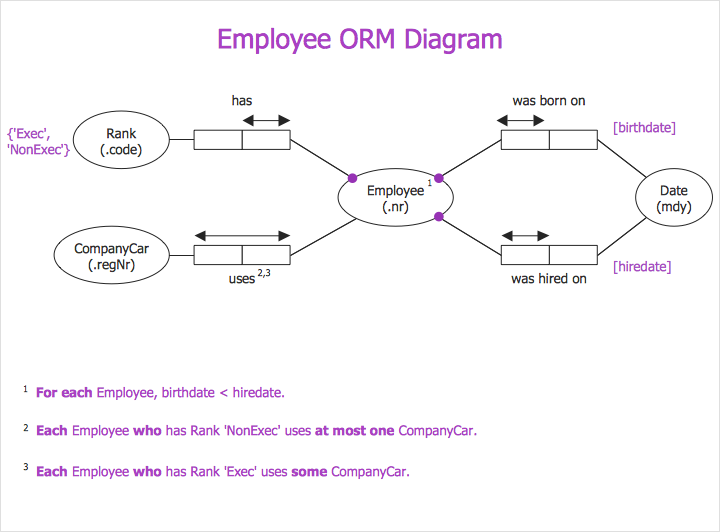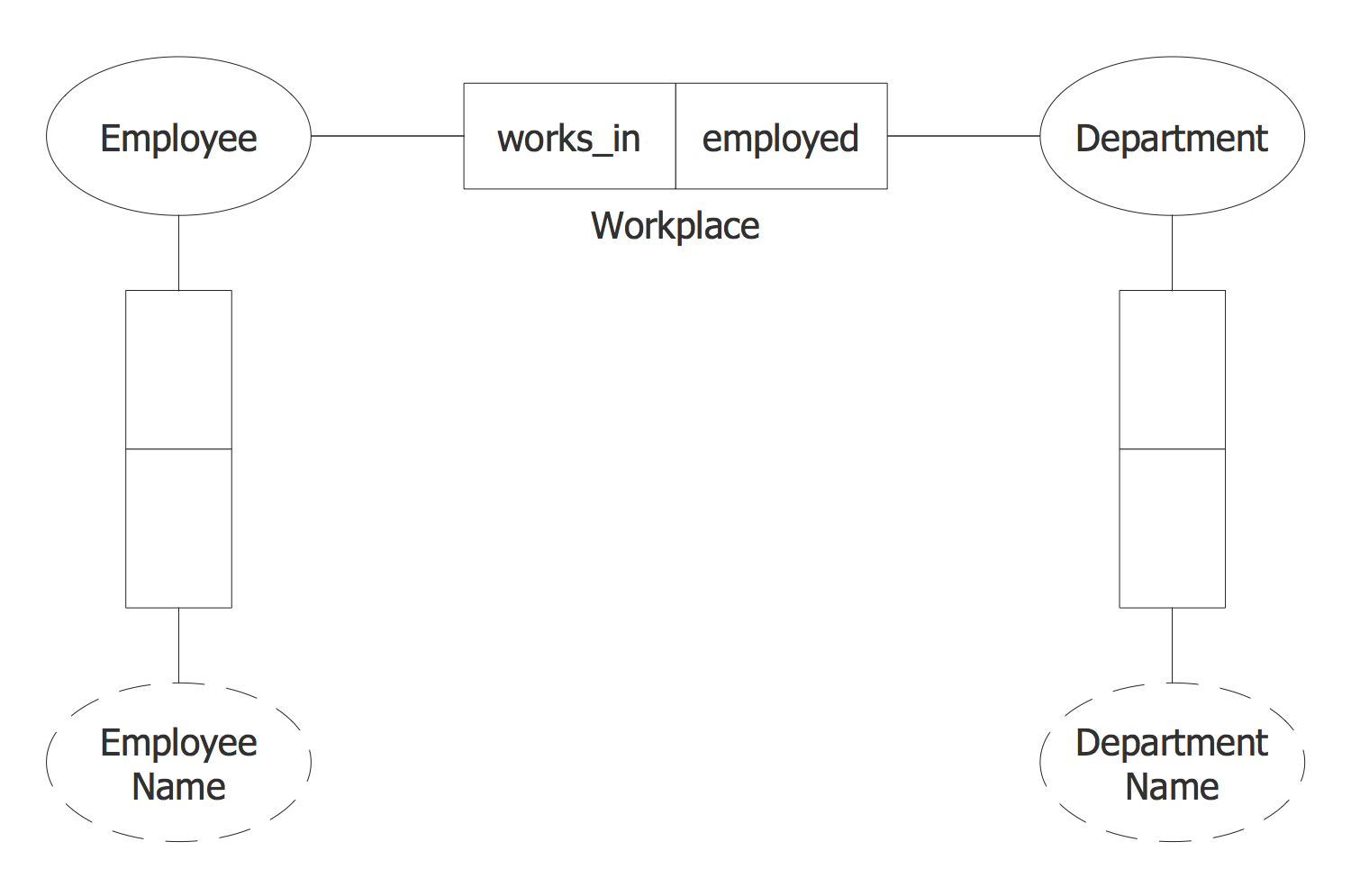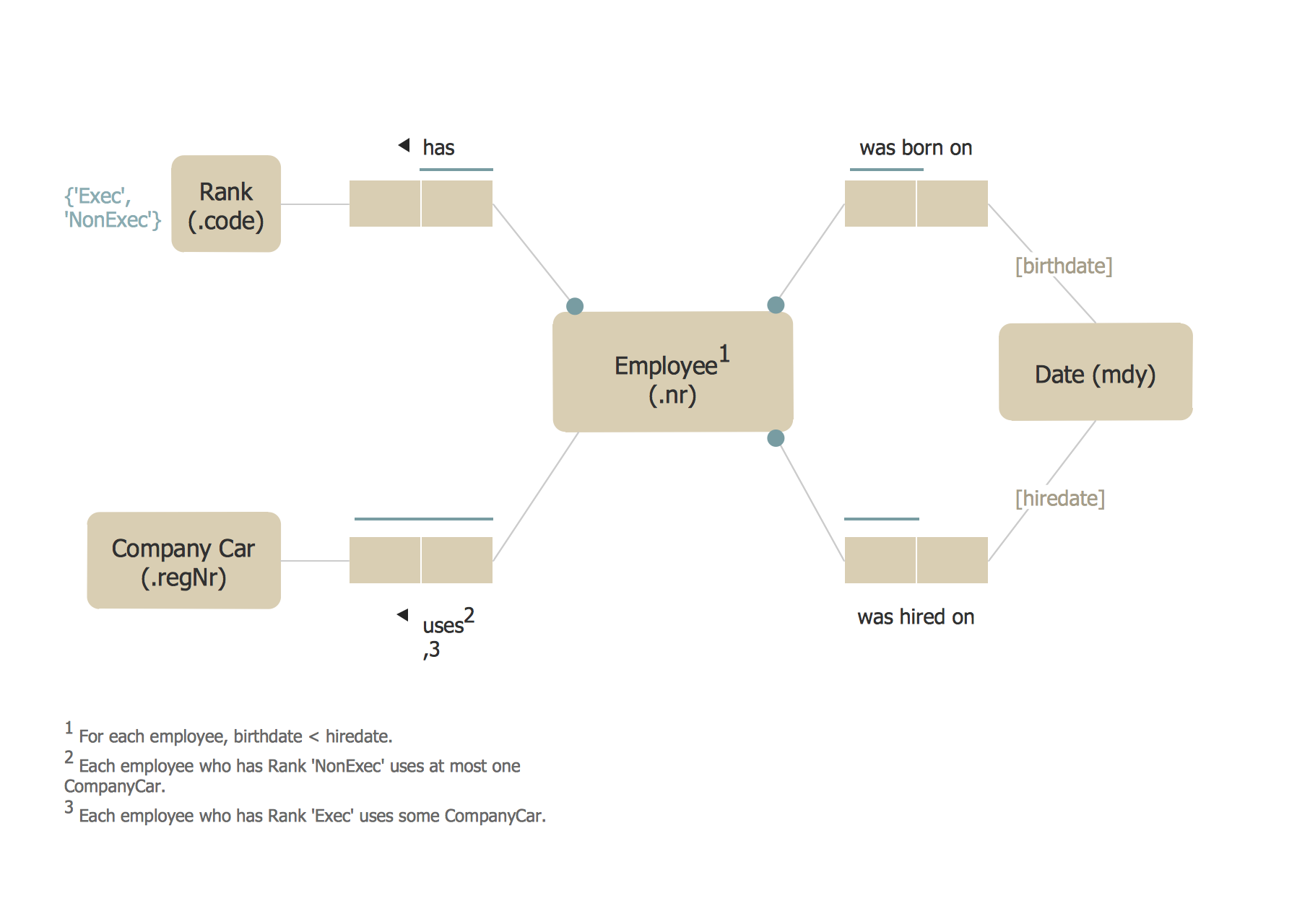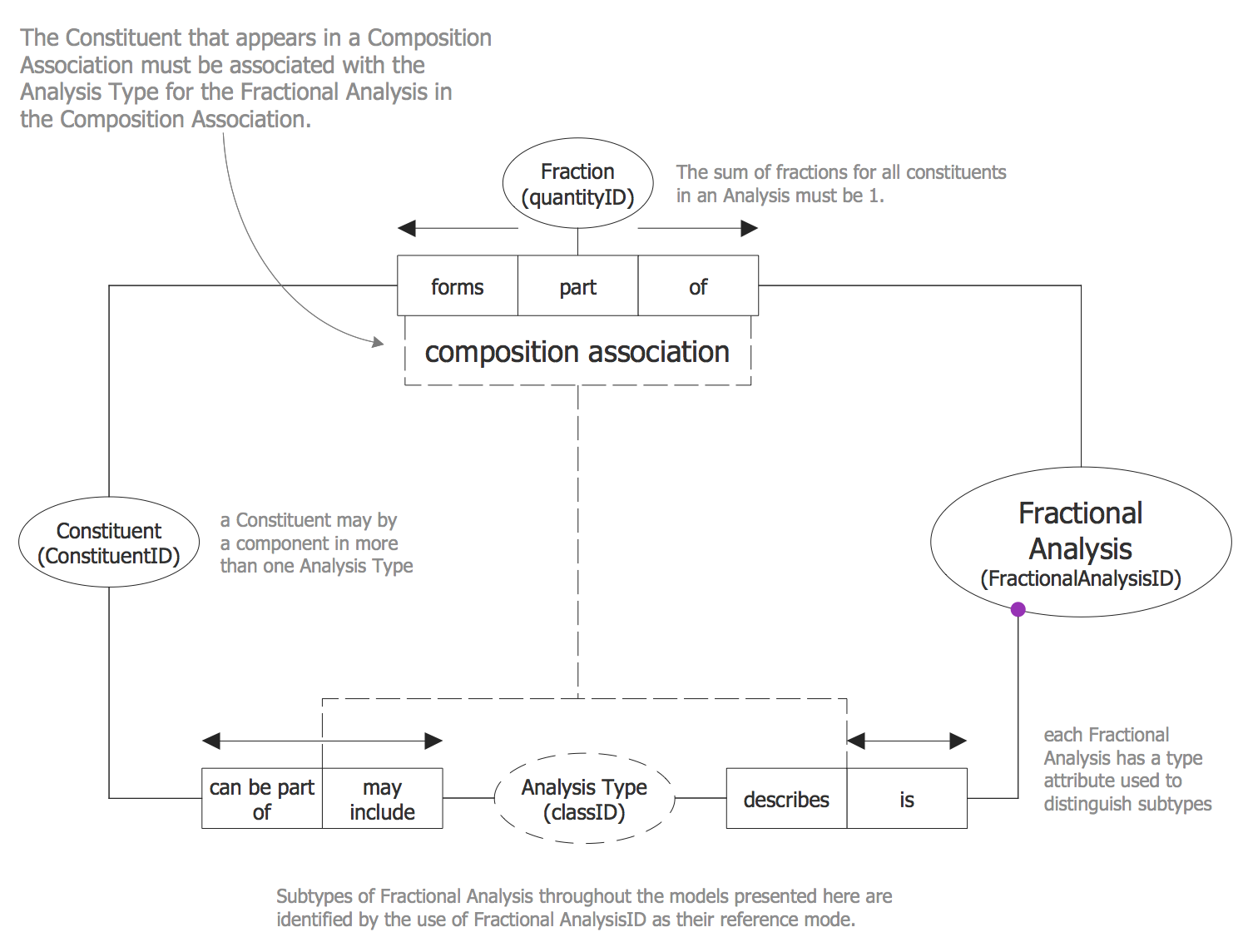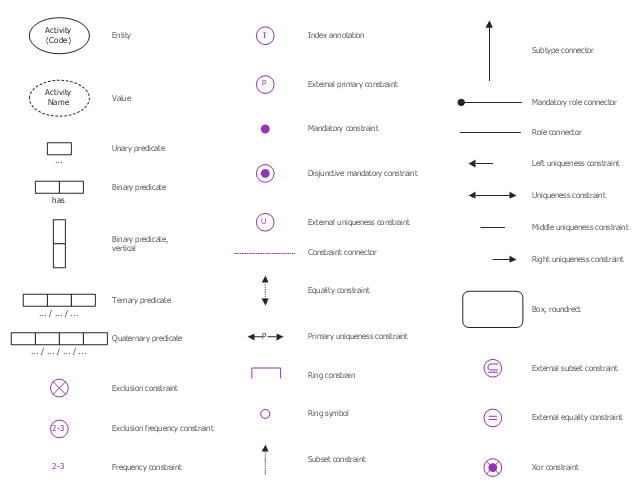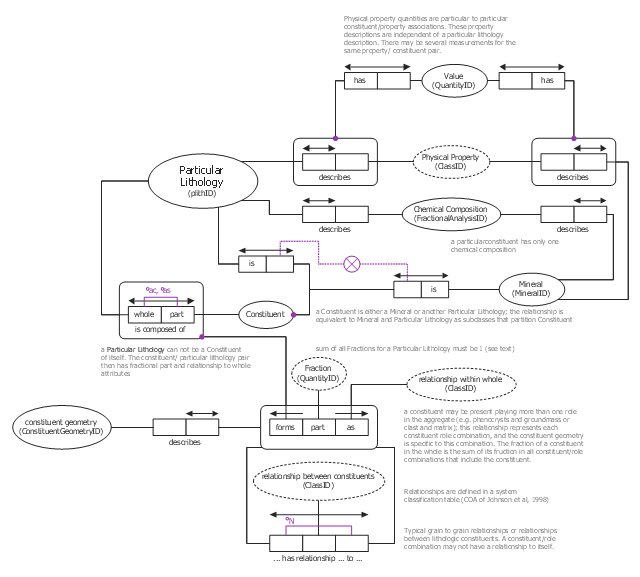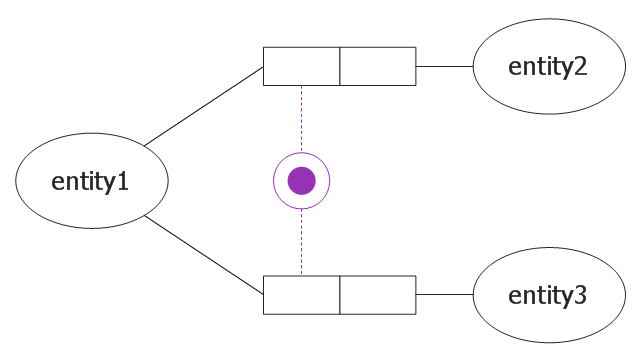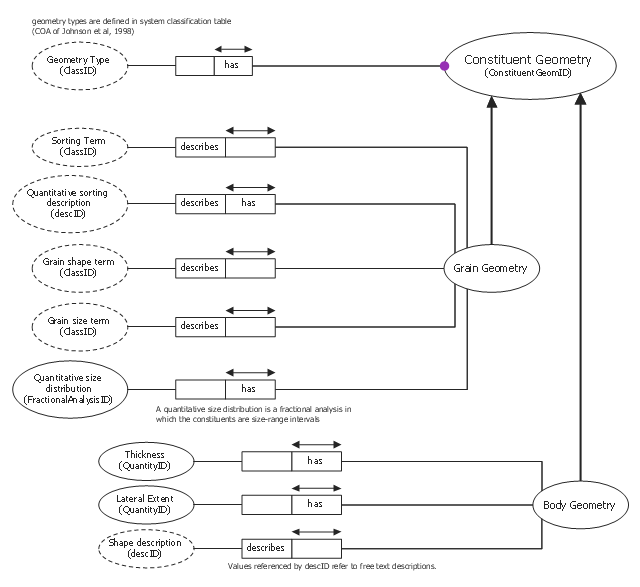 Object-Role Modeling (ORM) Diagrams
Object-Role Modeling (ORM) Diagrams
Object-role Modeling (ORM) Diagram solution with powerful vector diagramming and data modeling tools, large quantity of specially developed samples and examples, and rich variety of vector objects corresponding to common ORM notation, ideally suits for developing the comprehensive, clear and visual Object-role Modeling (ORM) diagrams and schematics, understandable for all interested people from the different fields and business directions, for designing the ORM models, and demonstrating advantages from the use of ORM and its notation. It is intended for software developers and computer engineers, specialists in a field of Object-oriented programming (OOP), database architects, web-application constructors and developers, etc.
HelpDesk
How to Create an Object-Role Modeling (ORM) Diagram
Object Role Modeling (ORM) Diagrams solution extends the ConceptDraw DIAGRAM software functionality with powerful vector diagramming and data modeling tools, large quantity of specially developed samples and examples, and rich variety of vector objects corresponding to common ORM notation, which are convenient for using when developing the comprehensive, clear and visual Object Role Modeling (ORM) diagrams and schematics.ORM
In case some ORM drawing has to be created, such as an ORM diagram, it can become possible once the ConceptDraw DIAGRAM diagramming and drawing software is downloaded from this site being used with another product of CSO — the ConceptDraw STORE. Having the last-mentioned application, you can choose to install the Object-Role Modeling (ORM) solution in order to make any needed ORM diagram by using the pre-made templates of such drawings as well as the vector stencil libraries from the mentioned solution.ORM Diagram
The vector stencils library ORM Diagrams from the solution Software Development contains specific ORM symbols for ConceptDraw DIAGRAM diagramming and vector drawing software. The Software Development solution is contained in the ConceptDraw Solution Park.Software Engineering
For database modeling, such as graph databases and/or relational databases modelling, for business rules modeling, for XML-Schemas modeling, data warehouses modeling or for web forms modeling — it does not matter what your reasons for creating the ORM diagrams are, you can always make any needed ORM-related drawings with the aid of ConceptDraw DIAGRAM and ConceptDraw STORE that can simplify your work by providing the so-called “Object-Role Modeling (ORM) solution” as a great ORM diagram drawing tool, including the ORM-related vector stencils libraries, ORM diagram samples and templates as well as learning media.The vector stencils library "ORM diagram" contains 32 object-role modeling (ORM) notation symbols.
Use it to design your ORM diagrams with ConceptDraw PRO software in data modeling and software engineering.
The vector stencils example "Design elements - ORM diagram" is included in ORM Diagrams solution from Software Development area of ConceptDraw Solution Park.
Use it to design your ORM diagrams with ConceptDraw PRO software in data modeling and software engineering.
The vector stencils example "Design elements - ORM diagram" is included in ORM Diagrams solution from Software Development area of ConceptDraw Solution Park.
This object-role modeling (ORM) diagram sample shows schema for particular lithology.
It was designed on the base of the Wikimedia Commons file: Schema for Particular Lithology.gif. [commons.wikimedia.org/ wiki/ File:Schema_ for_ Particular_ Lithology.gif]
"The Particular Lithology schema (Figure 5) models the description of a particular rock. The information system should include a set of idealized "typical' Particular Lithology entities associated with each General Lithology to provide default values for characteristics not specified in the General Lithology definition. The Particular Lithology entity will also be used for the description of rock hand samples. A Particular Lithology is modeled as an aggregate of Constituents. The Constituents may be Mineral or other Particular Lithology entities, allowing for recursive description. Each Constituent may be involved in one or more Relationship_ within_ Whole associations (see Table 1 for examples) with the Particular Lithology." [pubs.usgs.gov/ of/ 1999/ of99-386/ richard.html]
The object-role model example "Particular lithology ORM diagram" was designed using ConceptDraw PRO software extended with ORM Diagrams solution from Software Development area of ConceptDraw PRO Solution Park.
It was designed on the base of the Wikimedia Commons file: Schema for Particular Lithology.gif. [commons.wikimedia.org/ wiki/ File:Schema_ for_ Particular_ Lithology.gif]
"The Particular Lithology schema (Figure 5) models the description of a particular rock. The information system should include a set of idealized "typical' Particular Lithology entities associated with each General Lithology to provide default values for characteristics not specified in the General Lithology definition. The Particular Lithology entity will also be used for the description of rock hand samples. A Particular Lithology is modeled as an aggregate of Constituents. The Constituents may be Mineral or other Particular Lithology entities, allowing for recursive description. Each Constituent may be involved in one or more Relationship_ within_ Whole associations (see Table 1 for examples) with the Particular Lithology." [pubs.usgs.gov/ of/ 1999/ of99-386/ richard.html]
The object-role model example "Particular lithology ORM diagram" was designed using ConceptDraw PRO software extended with ORM Diagrams solution from Software Development area of ConceptDraw PRO Solution Park.
This object-role modeling (ORM) diagram sample shows disjunctive mandatory role constraint.
It was designed on the base of the Wikimedia Commons file: 9 DisjunktyvusPrivalomumoRibojimas.jpg. [commons.wikimedia.org/ wiki/ File:9_ DisjunktyvusPrivalomumoRibojimas.jpg]
"2.7. Mandatory Role Constraints.
The ORM 1 tool indicates simple mandatory constraints by a solid dot either (a) at the intersection of an entity type shape and the line connecting it to a role, or (b) at the role end. Option (b) is needed to avoid ambiguity when an object type plays many mandatory roles whose connections to the object type are too close to distinguish which role the dot applies to. Currently, disjunctive mandatory (inclusive-or) constraints are depicted by placing the solid dot in a circle connected by dotted lines to the roles it applies to. ORM 2 retains this notation, except that the solid dot is consistently colored violet and a global configuration option determines the default placement of simple mandatory dots at the role or object type end. Users may override this global setting on an individual role basis." [www.orm.net/ pdf/ ORM2_ TechReport1.pdf]
The object-role model example "Disjunctive mandatory constraint ORM diagram" was designed using ConceptDraw PRO software extended with ORM Diagrams solution from Software Development area of ConceptDraw PRO Solution Park.
It was designed on the base of the Wikimedia Commons file: 9 DisjunktyvusPrivalomumoRibojimas.jpg. [commons.wikimedia.org/ wiki/ File:9_ DisjunktyvusPrivalomumoRibojimas.jpg]
"2.7. Mandatory Role Constraints.
The ORM 1 tool indicates simple mandatory constraints by a solid dot either (a) at the intersection of an entity type shape and the line connecting it to a role, or (b) at the role end. Option (b) is needed to avoid ambiguity when an object type plays many mandatory roles whose connections to the object type are too close to distinguish which role the dot applies to. Currently, disjunctive mandatory (inclusive-or) constraints are depicted by placing the solid dot in a circle connected by dotted lines to the roles it applies to. ORM 2 retains this notation, except that the solid dot is consistently colored violet and a global configuration option determines the default placement of simple mandatory dots at the role or object type end. Users may override this global setting on an individual role basis." [www.orm.net/ pdf/ ORM2_ TechReport1.pdf]
The object-role model example "Disjunctive mandatory constraint ORM diagram" was designed using ConceptDraw PRO software extended with ORM Diagrams solution from Software Development area of ConceptDraw PRO Solution Park.
This object-role modeling (ORM) diagram sample shows schema for constituent geometry. It was designed on the base of the Wikimedia Commons file: Schema for Constituent Geometry.gif. [commons.wikimedia.org/ wiki/ File:Schema_ for_ Constituent_ Geometry.gif]
"Constituent Geometry... models a data structure for describing the geometry of individual constituents in a Particular Lithology. These descriptions are based on terms that may have qualitative or quantitative definitions (e.g. round, subround, euhedral, subhedral, fine-grained) or on free text descriptions referenced by "descID'. The Constituent Geometry description has two sub-classes, Grain Geometry and Body Geometry, because different terminology is used when describing individual grains or lithologic components in a mixed rock." [pubs.usgs.gov/ of/ 1999/ of99-386/ richard.html]
The object-role modeling diagram example "Constituent geometry ORM diagram" was designed using ConceptDraw PRO software extended with ORM Diagrams solution from Software Development area of ConceptDraw PRO Solution Park.
"Constituent Geometry... models a data structure for describing the geometry of individual constituents in a Particular Lithology. These descriptions are based on terms that may have qualitative or quantitative definitions (e.g. round, subround, euhedral, subhedral, fine-grained) or on free text descriptions referenced by "descID'. The Constituent Geometry description has two sub-classes, Grain Geometry and Body Geometry, because different terminology is used when describing individual grains or lithologic components in a mixed rock." [pubs.usgs.gov/ of/ 1999/ of99-386/ richard.html]
The object-role modeling diagram example "Constituent geometry ORM diagram" was designed using ConceptDraw PRO software extended with ORM Diagrams solution from Software Development area of ConceptDraw PRO Solution Park.
- ORM Diagram | Express-G Diagram | SSADM Diagram | Orm Diagram
- ORM Diagram | Software Diagrams | SSADM Diagram | Freeware To ...
- New Object-Role Modeling Diagrams Solution for ConceptDraw PRO
- Design elements - HR department | ORM Diagram | Types Of ...
- Flow chart Example. Warehouse Flowchart | ORM Diagram | Flow ...
- Process Flowchart | ORM Diagram | Illustration Software | Hire ...
- Orm
- Process Flowchart | ORM Diagram | Block Diagram Of Rational ...
- Rack Diagrams | Sequence Diagram for Cloud Computing | Is ...
- ATM UML Diagrams | SYSML | Entity-Relationship Diagram (ERD ...
